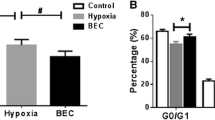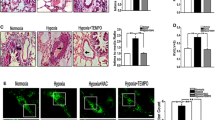Abstract
Objective
Pulmonary hypertension (PH) is a severe pulmonary vascular disease that eventually leads to right ventricular failure and death. The purpose of this study was to investigate the mechanism by which pachymic acid (PA) pretreatment affects PH and pulmonary vascular remodeling in rats.
Methods
PH was induced via hypoxia exposure and administration of PA (5 mg/kg per day) in male Sprague-Dawley rats. Hemodynamic parameters were measured using a right ventricular floating catheter and pulmonary vascular morphometry was measured by hematoxylin-eosin (HE), α-SMA and Masson staining. MTT assays and EdU staining were used to detect cell proliferation, and apoptosis was analyzed by TUNEL staining. Western blotting and immunohistochemistry were used to detect the expression of proteins related to the Nrf2-Keap1-ARE pathway.
Results
PA significantly alleviated hypoxic PH and reversed right ventricular hypertrophy and pulmonary vascular remodeling. In addition, PA effectively inhibited proliferation and promoted apoptosis in hypoxia-induced pulmonary artery smooth muscle cells (PASMCs). Moreover, PA pretreatment inhibited the expression of peroxy-related factor (MDA) and promoted the expression of antioxidant-related factors (GSH-PX and SOD). Furthermore, hypoxia inhibited the Nrf2-Keap1-ARE signaling pathway, while PA effectively activated this pathway. Most importantly, addition of the Nrf2 inhibitor ML385 reversed the inhibitory effects of PA on ROS generation, proliferation, and apoptosis tolerance in hypoxia-induced PASMCs.
Conclusion
Our study suggests that PA may reverse PH by regulating the Nrf2-Keap1-ARE signaling pathway.
Similar content being viewed by others
References
Zhong N, Wang C, Yao W, et al. Prevalence of chronic obstructive pulmonary disease in China: a large, population-based survey. Am J Respir Crit Care Med, 2007,176(8):753–760
Orr R, Smith LJ, Cuttica MJ. Pulmonary hypertension in advanced chronic obstructive pulmonary disease. Curr Opin Pulm Med, 2012,18(2):138–143
Hansen T, Galougahi KK, Celermajer D, et al. Oxidative and nitrosative signaling in pulmonary arterial hypertension-Implications for development of novel therapies. Pharmacol Ther, 2016,165:50–62
Montani D, Chaumais MC, Guignabert C, et al. Targeted therapies in pulmonary arterial hypertension. Pharmacol Ther, 2014,141(2):172–191
Qipshidze N, Tyagi N, Metreveli N, et al. Autophagy mechanism of right ventricular remodeling in murine model of pulmonary artery constriction, Am J Physiol Heart Circ Physiol, 2012,302(3):H688–H696
Holmström KM, Kostov RV, Dinkova-Kostova AT. The multifaceted role of Nrf2 in mitochondrial function. Curr Opin Toxicol, 2016,1:80–91
Liu Q, Lei Z, Huang A, et al. Toxic metabolites, MAPK and Nrf2/Keap1 signaling pathways involved in oxidative toxicity in mice liver after chronic exposure to Mequindox. Sci Rep, 2017,7:41854
Muscarella LA, Fazio VM. Keap1/Nrf2 impairing revised: are we missing the single nucleotide polymorphisms? J Thorac Dis, 2016,8(12):E1752–E1754
Wu H, Zhao J, Chen M, et al. The Anti-Aging Effect of Erythropoietin via the ERK/Nrf2-ARE Pathway in Aging Rats. J Mol Neurosci, 2017,61(3):449–458
Kamalakannan Preethi O, Sampath V, Ravikumar N, et al. Comparative Evaluation of Physicochemical Properties and Apical Sealing Ability of a Resin Sealer Modified with Pachymic Acid. Eur Endod J, 2020,5(1): 23–27
Lu J, Fu L, Qin G, et al. The regulatory effect of Xiaoyao San on glucocorticoid receptors under the condition of chronic stress. Cell Mol Biol (Noisy-legrand), 2018,64(6):103–109
Li Y, Li X, Lu Y, et al. Co-delivery of Poria cocos extract and doxorubicin as an “all-in-one” nanocarrier to combat breast cancer multidrug resistance during chemotherapy. Nanomedicine, 2020,23:102095.
Jiang Y, Fan L. Evaluation of anticancer activities of Poria cocos ethanol extract in breast cancer: In vivo and in vitro, identification and mechanism. J Ethnopharmacol, 2020,257:112851
Sun KX, Xia HW. Pachymic acid inhibits growth and induces cell cycle arrest and apoptosis in gastric cancer SGC-7901 cells. Oncol Lett, 2018,16(2):2517–2524
Gao Y, Wang P, Wang Y, et al. In Vitro and In Vivo Activity of Fomitopsis Pinicola (Sw. Ex Fr.) Karst Chloroform (Fpkc) Extract Against S180 Tumor Cells. Cell Physiol Biochem, 2017,44(5):2042–2056
Chen L, Chen DQ, Wang M, et al. Role of RAS/Wnt/β-catenin axis activation in the pathogenesis of podocyte injury and tubulo-interstitial nephropathy. Chem Biol Interact, 2017,273:56–72
Cai ZY, Sheng ZX, Yao H. Pachymic acid ameliorates sepsis-induced acute kidney injury by suppressing inflammation and activating the Nrf2/HO-1 pathway in rats. Eur Rev Med Pharmacol Sci, 2017,21(8):1924–1931
Jin J, Zhou R, Xie J, et al. Insights into Triterpene Acids in Fermented Mycelia of Edible Fungus Poria cocos by a Comparative Study. Molecules, 2019,24(7):1331
Ling H, Zhang Y, Ng KY, et al. Pachymic acid impairs breast cancer cell invasion by suppressing nuclear factor-κB-dependent matrix metalloproteinase-9 expression. Breast Cancer Res Treat, 2011,126(3):609–620
Spiekerkoetter E, Kawut SM, de Jesus Perez VA. New and Emerging Therapies for Pulmonary Arterial Hypertension. Annu Rev Med, 2019,70:45–59
Mei L, Zheng YM, Song T, et al. Rieske iron-sulfur protein induces FKBP12.6/RyR2 complex remodeling and subsequent pulmonary hypertension through NF-κB/cyclin D1 pathway. Nat Commun, 2020,11(1):3527
Arnold ND, Pickworth JA, West LE, et al. A therapeutic antibody targeting osteoprotegerin attenuates severe experimental pulmonary arterial hypertension. Nat Commun, 2019,10(1):5183
Hoeper MM, Ghofrani HA, Grünig E, et al. Pulmonary Hypertension. Dtsch Arztebl Int, 2017,114(5):73–84
Kovac S, Angelova PR, Holmström KM, et al. Nrf2 regulates ROS production by mitochondria and NADPH oxidase. Biochim Biophys Acta, 2015,1850(4):794–801
Bellezza I, Giambanco I, Minelli A, et al. Nrf2-Keap1 signaling in oxidative and reductive stress. Biochim Biophys Acta Mol Cell Res, 2018,1865(5):721–733
Suzuki T, Yamamoto M. Molecular basis of the Keap1-Nrf2 system. Free Radic Biol Med, 2015,88(Pt B):93–100
Martinez VD, Vucic EA, Thu KL, et al. Disruption of KEAP1/CUL3/RBX1 E3-ubiquitin ligase complex components by multiple genetic mechanisms: Association with poor prognosis in head and neck cancer. Head Neck, 2015,37(5):727–734
Kansanen E, Kuosmanen SM, Leinonen H, et al. The Keap1-Nrf2 pathway: Mechanisms of activation and dysregulation in cancer. Redox Biol, 2013,1(1):45–49
Krajka-Kuźniak V, Paluszczak J, Baer-Dubowska W. The Nrf2-ARE signaling pathway: An update on its regulation and possible role in cancer prevention and treatment. Pharmacol Rep, 2017,69(3):393–402
Jin A, Li B, Li W, et al. PHLPP2 downregulation protects cardiomyocytes against hypoxia-induced injury through reinforcing Nrf2/ARE antioxidant signaling. Chem Biol Interact, 2019,314:108848
Author information
Authors and Affiliations
Corresponding author
Ethics declarations
The authors declare that they have no conflicts of interest concerning this article.
Additional information
This project was supported by the Natural Science Foundation of Hubei Province (No. 2017CFB769).
Rights and permissions
About this article
Cite this article
He, Y., Zhong, Jh., Wei, Xd. et al. Pachymic Acid Ameliorates Pulmonary Hypertension by Regulating Nrf2-Keap1-ARE Pathway. CURR MED SCI 42, 56–67 (2022). https://doi.org/10.1007/s11596-021-2414-2
Received:
Accepted:
Published:
Issue Date:
DOI: https://doi.org/10.1007/s11596-021-2414-2




